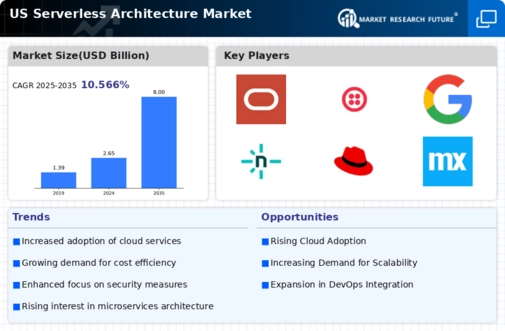Scalability and Flexibility
Scalability and flexibility are critical drivers propelling the serverless architecture market forward. Businesses are increasingly drawn to serverless solutions due to their ability to automatically scale applications in response to varying workloads. This capability is particularly advantageous for companies experiencing fluctuating demand, as it allows them to handle spikes in traffic without the need for manual intervention. According to recent data, approximately 70% of organizations report that scalability is a primary factor in their decision to adopt serverless technologies. Additionally, the flexibility offered by serverless architectures enables developers to focus on writing code rather than managing infrastructure, which can lead to faster deployment times and improved time-to-market for new applications. This dynamic is likely to enhance the competitive edge of businesses utilizing serverless solutions in the evolving digital landscape.
Enhanced Developer Productivity
The serverless architecture market is significantly influenced by the drive for enhanced developer productivity. By abstracting the underlying infrastructure, serverless platforms allow developers to concentrate on writing and deploying code without the complexities of server management. This shift can lead to a reduction in development time by as much as 40%, enabling teams to deliver applications more rapidly. Furthermore, the integration of serverless frameworks with popular development tools and environments fosters a more streamlined workflow, which is appealing to organizations aiming to innovate quickly. As businesses increasingly prioritize agility and speed in their software development processes, the serverless architecture market is poised for growth, as it aligns with the need for efficient and effective development practices.
Cost Efficiency and Resource Optimization
The serverless architecture market is experiencing a notable shift towards cost efficiency and resource optimization. Organizations are increasingly adopting serverless models to reduce operational costs associated with traditional server management. By leveraging serverless solutions, companies can eliminate the need for provisioning and maintaining servers, which can lead to savings of up to 30% in infrastructure costs. This trend is particularly pronounced among small to medium-sized enterprises (SMEs) that seek to maximize their IT budgets. Furthermore, the pay-as-you-go pricing model inherent in serverless architectures allows businesses to only pay for the compute resources they actually use, further enhancing financial efficiency. As a result, the serverless architecture market is likely to see continued growth as more organizations recognize the financial benefits of this approach.
Growing Demand for Real-Time Data Processing
The growing demand for real-time data processing is a pivotal driver in the serverless architecture market. Organizations are increasingly seeking solutions that can handle large volumes of data in real-time, particularly in sectors such as finance, e-commerce, and IoT. Serverless architectures facilitate this need by providing the capability to process data streams efficiently without the overhead of managing servers. Recent statistics indicate that around 60% of enterprises are investing in real-time analytics solutions, which often leverage serverless technologies. This trend is likely to continue as businesses recognize the value of timely insights for decision-making and customer engagement. Consequently, the serverless architecture market is expected to expand as more organizations adopt these solutions to meet their real-time processing needs.
Increased Focus on Innovation and Experimentation
An increased focus on innovation and experimentation is driving growth in the serverless architecture market. Organizations are increasingly adopting serverless models to foster a culture of experimentation, allowing teams to test new ideas and features without the constraints of traditional infrastructure. This approach not only accelerates the development cycle but also encourages creativity among developers. Data suggests that companies utilizing serverless architectures are 50% more likely to experiment with new technologies and methodologies. As businesses strive to remain competitive in a rapidly evolving market, the ability to innovate quickly becomes paramount. Thus, the serverless architecture market is likely to benefit from this trend, as more organizations seek to leverage serverless solutions to enhance their innovation capabilities.
























Leave a Comment